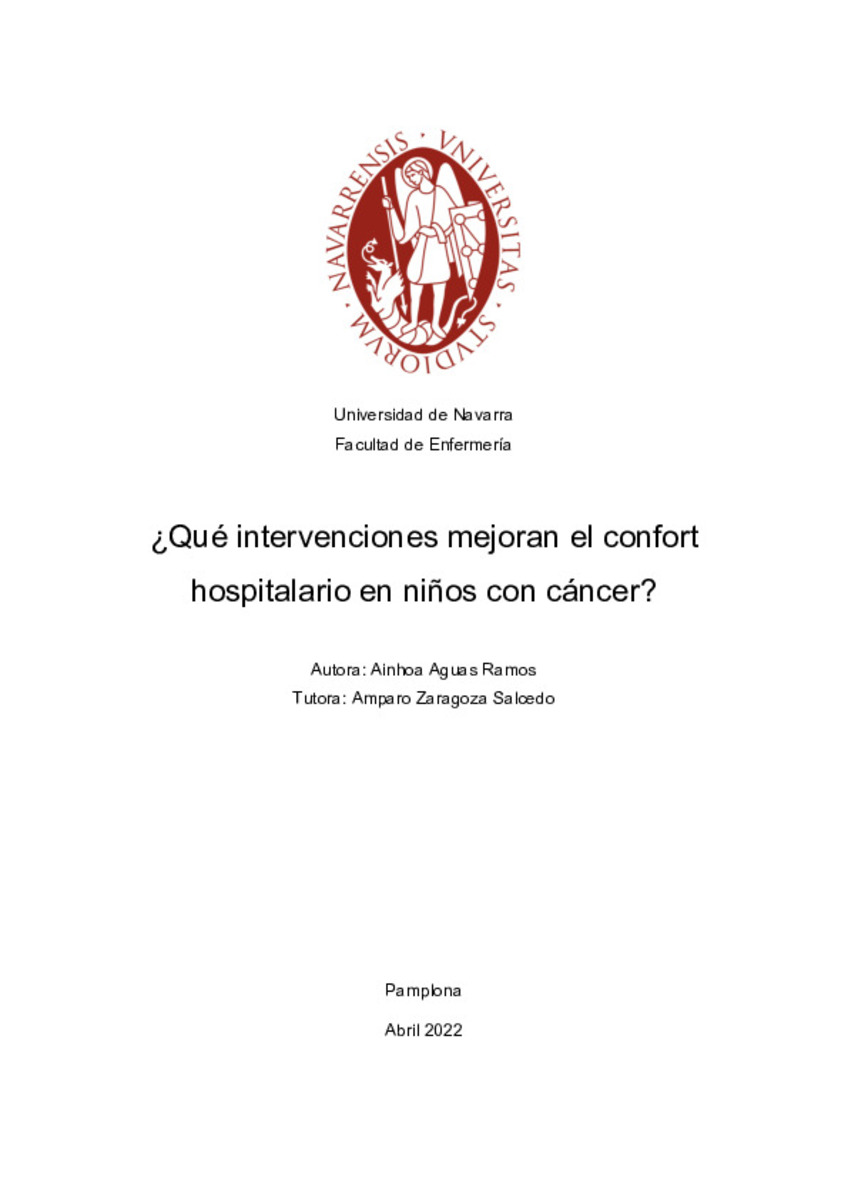Full metadata record
| DC Field | Value | Language |
|---|---|---|
| dc.contributor.advisor | Zaragoza-Salcedo, A. (Amparo) | - |
| dc.creator | Aguas-Ramos, A. (Ainhoa) | - |
| dc.date.accessioned | 2022-11-18T12:59:28Z | - |
| dc.date.available | 2022-11-18T12:59:28Z | - |
| dc.date.issued | 2022 | - |
| dc.date.submitted | 2022 | - |
| dc.identifier.uri | https://hdl.handle.net/10171/64703 | - |
| dc.description.abstract | Introducción: El ingreso hospitalario en los niños con cáncer supone un cambio radical en sus vidas. Tienen que enfrentarse a otra realidad en la que experimentan sufrimiento, miedo y ansiedad. Por eso, necesitan intervenciones que les proporcionen una sensación de bienestar. Objetivo: Conocer qué intervenciones no farmacológicas mejoran el confort de los niños con cáncer durante su estancia hospitalaria. Metodología: Se realizó una revisión bibliográfica en las bases de datos PubMed, Cinahl y PsycInfo durante los meses de octubre de 2021 a enero de 2022. Resultados: Se identificaron cuatro tipos de intervenciones: realidad virtual, terapia de artes creativas, terapia con animales y programa de payasos. Todas ellas tuvieron un impacto positivo en distintos aspectos de la persona, desde mejoras en el estado de ánimo hasta disminución de la ansiedad. Conclusiones: Se ha visto como las intervenciones mejoran el confort de los niños ayudándoles de esta forma a lidiar con el proceso oncológico durante su hospitalización. Por tanto, es importante seguir investigando para poder implementarlas en la práctica clínica. | es_ES |
| dc.description.abstract | Introduction: Hospital admission for children with cancer is a radical change in their lives. They have to face another reality in which they experience suffering, fear and anxiety. Therefore, they need interventions that provide them with a sense of well-being. Objective: To know which non-pharmacological interventions improve the comfort of children with cancer during their hospital stay. Methodology: A literature review was conducted in PubMed, Cinahl and PsycInfo databases during the months of October 2021 to January 2022.Results: Four types of interventions were identified: virtual reality, creative arts therapy, animal therapy and clown program. All of them had a positive impact on different aspects of the person, from improvements in mood to decreased anxiety. Conclusion: Interventions have been shown to improve the comfort of children, helping them to cope with the oncologic process during their hospitalization. Therefore, it is important to continue research in order to implement them in clinical practice. | es_ES |
| dc.language.iso | spa | es_ES |
| dc.rights | info:eu-repo/semantics/openAccess | es_ES |
| dc.subject | Materias Investigacion::Ciencias de la Salud::Enfermería | es_ES |
| dc.subject | Niño hospitalizado | es_ES |
| dc.subject | Terapia | es_ES |
| dc.subject | Confort del paciente | es_ES |
| dc.subject | Enfermería oncológica | es_ES |
| dc.subject | Child hospitalized | es_ES |
| dc.subject | Therapy | es_ES |
| dc.subject | Patient comfort | es_ES |
| dc.subject | Oncology nursing | es_ES |
| dc.title | ¿Qué intervenciones mejoran el confort hospitalario en niños con cáncer? | es_ES |
| dc.title.alternative | Which interventions improve hospital comfort in children with cancer? | es_ES |
| dc.type | info:eu-repo/semantics/bachelorThesis | es_ES |
Files in This Item:
Statistics and impact
Items in Dadun are protected by copyright, with all rights reserved, unless otherwise indicated.






